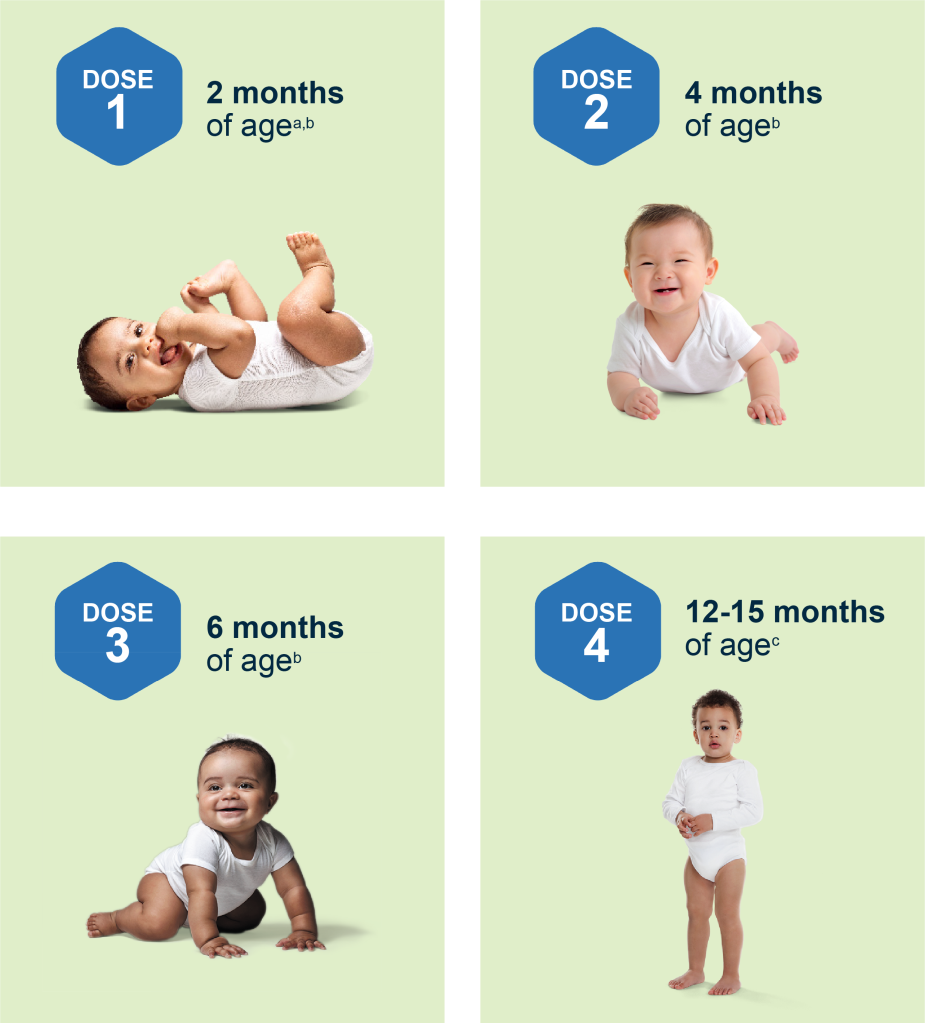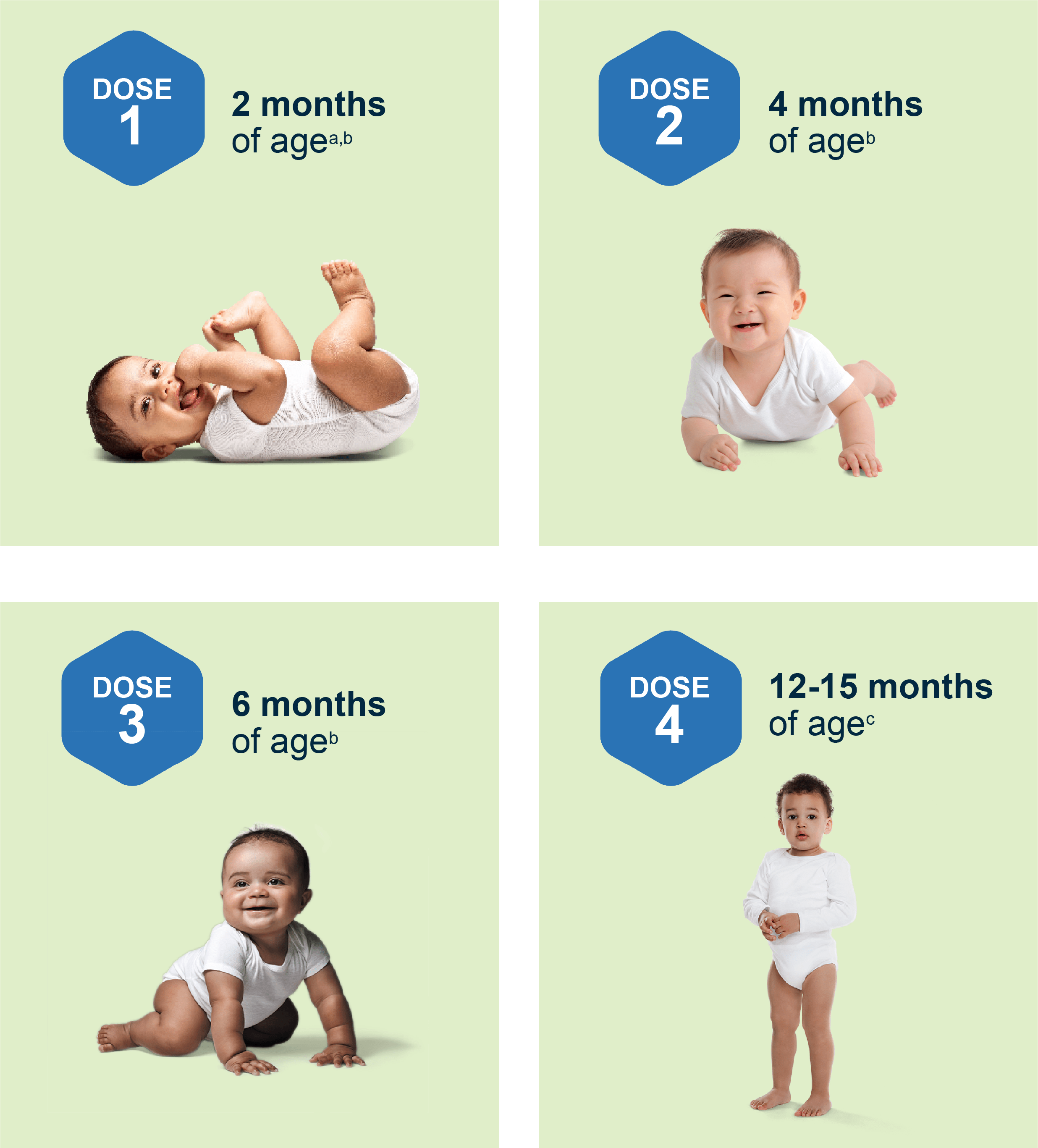
Guidance on pediatric dosage and administration of VAXNEUVANCE
VAXNEUVANCE—a CDC, AAP, and AAFP recommended option for all of your appropriate pediatric patients—is administered as a 4-dose series1-4


aDose 1 may be given as early as 6 weeks of age.
bThe recommended interval between doses is 4 to 8 weeks.
cThe 4th dose should be administered at approximately 12 through 15 months of age and at least 2 months after the 3rd dose.
How to administer VAXNEUVANCE
VAXNEUVANCE is for intramuscular injection only. Each dose is 0.5 mL.
Hold the prefilled syringe horizontally and shake vigorously immediately prior to use to obtain an opalescent suspension. Do not use the vaccine if it cannot be resuspended. Do not use if particulate matter or discoloration is observed.
VAXNEUVANCE can be given with other routinely administered vaccines (including Pentacel, RECOMBIVAX HB®, RotaTeq®, M-M-R®II, VAQTA®, VARIVAX®, and Hiberix).
Brands mentioned are trademarks of their respective owners.
Did you know?
VAXNEUVANCE is available through
the VFC Program5


You have brand choice—choose VAXNEUVANCE for your patients enrolled in the Vaccines for Children Program.5,6
Parents and caregivers of your pediatric patients may be unaware of vaccination programs, such as the VFC Program. VFC is a federally funded vaccine program that provides recommended vaccines to eligible children and adolescents who might not otherwise be able to afford them.6
AAP, American Academy of Pediatrics; AAFP, American Academy of Family Physicians; CDC, Centers for Disease Control and Prevention; VFC, Vaccines for Children.
Learn about storage & handling information
View details on reimbursement
Explore clinical data
Discover resources for your practice and patients
References
- Centers for Disease Control and Prevention. Recommended child and adolescent immunization schedule for ages 18 years or younger, United States 2024. Updated June 27, 2024. Accessed August 23, 2024. https://www.cdc.gov/vaccines/hcp/imz-schedules/downloads/child/0-18yrs-child-combined-schedule.pdf
- Immunizations. American Academy of Pediatrics. Last updated June 24, 2024. Accessed July 4, 2024. https://www.aap.org/en/patient-care/immunizations
- Immunization schedules. American Academy of Family Physicians. 2024. Accessed May 8, 2024. https://www.aafp.org/family-physician/patient-care/prevention-wellness/immunizations-vaccines/immunization-schedules.html
- Farrar J, Gierke R, Andrejko K, et al. ACIP updates: recommendations for use of 20-valent pneumococcal conjugate vaccine in children ― United States, 2023. MMWR Morb Mortal Wkly Rep. 2023;72:1072. doi: 10.15585/mmwr.mm7239a5
- Centers for Disease Control and Prevention (CDC). VFC. CDC Vaccine Price List. Updated October 1, 2024. Accessed October 14, 2024. https://www.cdc.gov/vaccines-for-children/php/awardees/current-cdc-vaccine-price-list.html?CDC_AAref_Val=https://www.cdc.gov/vaccines/programs/vfc/awardees/vaccine-management/price-list/index.html
- Centers for Disease Control and Prevention. About the Vaccines for Children (VFC) Program. Reviewed June 26, 2024. Accessed September 6, 2024. https://www.cdc.gov/vaccines-for-children/about/?CDC_AAref_Val=https://www.cdc.gov/vaccines/programs/vfc/about/index.html
